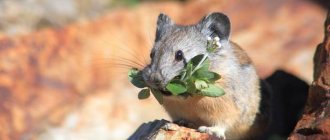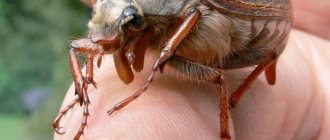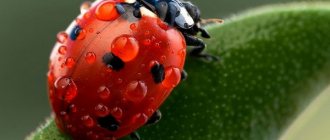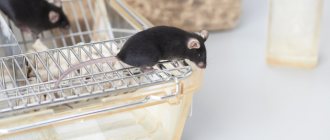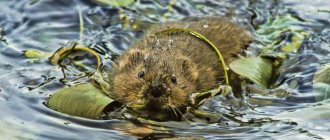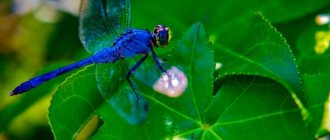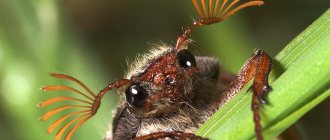Dragonfly larva and brief characteristics of the order
Dragonflies are a group of flying predatory insects. Representatives of this group of animals are distributed in the tropics, subtropics and areas with temperate climates. To date, about six thousand representatives of this order are known. These insects are characterized by an indirect mode of development, which includes a transitional stage (dragonfly larva) and an imago stage (adult). Both larvae and adults form the basis of the diet of some fish species. What are dragonflies?
What do adults look like?
Before the dragonfly larva is considered, it is necessary to learn more about the way of life of these insects. The adult is quite large, with a pronounced and mobile head. The organ of vision is the huge compound eyes, which occupy the entire upper part of the head. The insect's body is elongated and consists of a thoracic and abdominal part. The dragonfly's limbs are not very well developed, but they have bristles arranged in rows that act as a hunting basket, making it possible to hunt in flight.
Representatives of this group have two pairs of wings, which are almost the same size and actively participate in flight.
What do dragonflies eat? As already mentioned, these are predatory insects. Smaller species become their prey. Mostly these are midges, mosquitoes and other insect pests. The dragonfly itself usually becomes food for fish.
Reproduction and development of dragonflies
These insects mate in flight. On the abdomen you can see developed copulatory organs - in this way it is easy to distinguish a male from a female. Another interesting feature is that the male removes foreign sperm from the female’s copulatory apparatus before placing his own there. This phenomenon has no analogues in the wild.
The female then lays fertilized eggs. As a rule, oviposition is carried out either in water or on aquatic plants and much less often in moist soil. From each egg a dragonfly larva emerges.
The larvae of these insects live in water. Their body is olive-brown in color. They breathe using rectal gills and through the integument of the body. These creatures are inactive, but the way they move is worthy of attention. First, a portion of water is sucked through the anus, which is then sprayed out from there under high pressure. The recoil force pushes the insect in the opposite direction. In addition, the dragonfly larva can swim using gill plates, which perfectly replace fins.
Another feature of the larva is the presence of a so-called mask, which is represented by an overgrown lower lip. The mask plays the role of a grasping apparatus. Insects at this stage of development do not actively hunt - most of the time they sit on the bottom or attach themselves to an aquatic plant, waiting for prey, which they then grab, quickly throwing the mask forward.
The dragonfly larva feeds mainly on daphnia, mosquito larvae and other insects. Before the last molt, the insect climbs ashore and attaches itself to a plant. It is here that the larva transforms into an adult form - an adult.
It is worth noting that dragonflies are a fairly common group of insects. The order is further divided into two main suborders:
- Homoptera dragonflies. Representatives of this order have pairs of wings of equal size. Thanks to this structure, insects are characterized by a soft, fluttering flight. The larvae of such dragonflies live in flowing or stagnant bodies of water.
- Varied dragonflies. These insects have two pairs of large, almost transparent wings. In a calm state, their wings are placed perpendicular to the abdomen. It is worth noting that representatives of this group are considered one of the fastest insects. The larvae live either in a pond or in a swamp.
Interestingly, experienced fishermen quite often and successfully use these insects as bait.
We recommend checking out: https://fb.ru
It is very typical for the entire order of spiders to replace the primary copulatory organs absent in males with peculiarly modified pedipalps, or gonopalps, as V. Dogel (1940) calls them. Among arachnids, similar sperm transfer organs are present only in Ricinulei (on the third pair of legs), and in general are very rare (for example, the hectocotylated tentacle of Cephalopoda males).
The copulatory organs reach full development only after the last molt of the male; Before this, there are no particularly significant differences in the pedipalps of the male and female.
The benefits and harms of dragonflies
It is difficult to overestimate the benefits of dragonflies. Both larvae and adults are highly voracious and destroy insects harmful to humans. Dragonflies eat mosquitoes, which is an invaluable benefit for people and animals. On the African continent, these long-winged insects eat Tsetse flies in large numbers. In addition, they themselves become part of the food chain of fish and birds. Also, according to research conducted by the Siberian Federal University, dragonflies help transfer up to 7 kilograms of fatty acids from water bodies to terrestrial ecosystems, which are necessary for the proper nutrition of organisms. However, the excessive appetite of the larvae causes quite a lot of damage to fish farms. They eat not only fry, but also the main food of fish (mosquito larvae, daphnia, etc.).
Features of dragonflies
The structure of these organs is most clear in some Haplogynae, for example in Segestria (Fig. 83) and Scytodes. Proximally, on the tarsal segment of the pedipalp, a large pear-shaped appendage (bulbus genitalis), elongated into a thin spout (embolus), develops.
At the end of the spout lies a small hole leading into a long, spirally coiled, chitin-lined sperm reservoir, or spermophore. During mating, the embolus is inserted into the female's seminal receptacle.
The proximal position of the bulb appears to be secondary. In many other primitive spiders (Aviculariidae, Hypochilusy Oonopidae, etc.), the copulatory apparatus is almost as simple, but the bulb is located subterminal or even completely terminal. In Hypochilus it is partially immersed, while in Filistata it is entirely immersed in the invagination at the end of the tarsal segment.
With the complication of the copulatory apparatus (Fig. 84), a second appendage develops next to the embolus - the conductor, which serves as a vagina or sheath for the embolus and facilitates the introduction of the latter into the copulatory opening of the female (Atypus, Caponia, etc.).
The base of the bulbus, already in Segestria and Scytodes, is movably articulated with the tarsus by means of an articular membrane.
Growing strongly in Aviculariidae, Atypus and other forms, the latter acquires the ability to swell with blood. In Entelegynae, the articular membrane turns into a special sac-like organ - a blood receptacle, or haematodocha, which folds at rest, but at the moment of mating it expands, swelling like a bubble under blood pressure.
The blood receptacle is located in a deep hole (alveolus) on the surface of the tarsus, which is called the boat (cymbium). Sometimes the tarsus is shortened to the size of a small scale (Nephila). Often in Entelegynae the copulatory apparatus reaches extraordinary complexity. One of its significant changes is the spiral twisting of the inflated blood receptacle and the bulb itself. The spermophore, which already in Segestria has a spiral course, here is strongly elongated and twists repeatedly; in addition, its individual sections can be differentiated in the form of special glandular organs (Linyphiidae).
Complications in the chitinized parts of the apparatus are also significant, and most importantly, very diverse and serve in taxonomy as an excellent criterion for distinguishing species. The bulb can take various shapes and become very complicated due to the formation of special sclerites or membranous parts on it.
The first are represented by the so-called retinacula (hetinacula) - chitinous appendages of various shapes that serve to attach the bulb to the female copulatory organs during mating. The second, called hematodochulae, are membranous areas that are functionally similar to a blood receptacle and can, like it, swell when filled with blood.
Quite often the embolus becomes more complicated. In Entelegynae, it forms a sharply isolated chitinized appendage and often turns into a flexible, spirally twisted hollow thread, the length of which can exceed the length of the body (Delena, Isopoda - from Sparassidae, Hyptiotes - from Uloboridae, Tegenaria - from Agelenidae and Labulla - from Linyphiidae).
In parallel with the embolus, the conductor is lengthened and usually twisted. From a simple embolus case, it turns into a special targeting device. Twisting of the embolus and conductor occurs in one direction (Isopoda) or in different directions (Dictyna, Tegenaria ferruginea).
Sometimes the entire copulatory apparatus reaches a very significant size. Thus, in Theridiosoma and in some related genera of Araneidae, the bulbus is the same size as the entire cephalothorax.
Finally, often (Tetragnathidae, Araneidae, Linyphiidae) a special outgrowth also develops on the tarsus - paracymbium, which serves for attachment during mating; sometimes attachment hooks even develop on the tibia and femur of the pedipalp.
The male copulatory apparatus of Pholcidae stands apart.
In simpler cases (Ninetis, Modismus, etc.) the bulb has a simple pear-shaped shape, but in other genera it is very complex. Thus, in Pholcus phalangoides, in addition to the embolus, the bulb bears two more outgrowths. One of them, the uncus, is covered with peculiar scales, the other, the T-shaped appendix, is heavily chitinized. The tarsus also forms a distal outgrowth called procursus, which carries a soft membrane stretched between the teeth, which swells at the moment of mating.
In the question of the phylogenetic development of the male copulatory apparatus, decisive importance belongs to observations of its formation in ontogenesis.
As Burrows (1925) and Harm (1931, 1934) showed, in the ontogeny of Segestria and Salticidae the bulbus develops from the pretarsal segment, and the embolus from the claw. Accordingly, in Mugalomorphae (Eurypelma), the tendons of two muscles are attached to the base of the copulatory organ, in which it is easy to recognize the usual levator of the claw segment, attached, as in the unmodified pedipalp, in the tarsal segment, and the depressor, lying, as usual, in the tibia (Snodgrass, 1952). Obviously, the most primitive types of the copulatory apparatus should be sought in those spiders in which it is located terminally, such as, for example, Aviculariidae, Hypochilus, Filistata, Oonopidae (Comstock, 1913; Berland, 1932).
In Lipistius, on the contrary, the position of the apparatus is secondarily changed, and its high specialization indicates a special path of evolution of this genus.
In general, three types of copulatory apparatus are distinguished: a simple type Segestria, a complicated type characteristic of most Entelegynae and others, and a special type characteristic of Pholcidae. The first two represent successive stages of development; the formation path of the third type was probably special and independent.
There are 5,000 species of dragonflies in the world.
Graceful hunter - dragonfly
These are the largest flying insects. All of them are divided into heteroptera and homoptera. Different-winged dragonflies are larger in size than even-winged dragonflies, and besides, they fly better.
The insect's body consists of a head, chest and long abdomen, at the end of which there is a pair of forceps. Body length 3 - 12 cm. Color varied: white and green, yellow and red, blue and orange.
Graceful transparent wings are its decoration. There are many transverse and longitudinal veins on the wings, which have a strengthening function. A dark spot on the wing protects the fly from vibration in flight.
Agile flyers develop colossal speed; some species can cover distances at speeds of 100 km/h.
Basically, the flight speed of the “jumper” is 5 km/h. They cover hundreds of kilometers without stopping, and can expertly hover in the air and suddenly stop. When she sits on a branch or any solid ground, her wings do not fold, they are always in a straightened state.
Each individual has three pairs of legs covered with shields. In flight, they fold their limbs into a basket - this makes it more convenient to grab prey.
Their mouthparts are of the gnawing type. The lower lip is a harpoon, shoots and grabs prey. Large eyes help track prey and can see anything edible at a distance of 10 meters. The structure of the eyes is complex - faceted.
All dragonflies are predators. They feed mainly on mosquitoes, flies, moths and other insects, which they pursue with great speed.
Dragonflies live in Europe, Asia, America, Australia, and Africa.
They can be found in meadows, forest edges, fields, but there must be a body of water nearby. They lead a solitary lifestyle. Enemies - many birds, spiders.
When courting a female, the male performs a mating flight, at the same time driving away other contenders. Soon the female will lay about 200 eggs in fresh water, either in wood or on various parts of the plant. The development of an insect consists of three stages: egg - larva (naiad) - adult.
The larvae are inactive and spend their development in the fresh waters of the reservoir. In some species, development can last 5 years. Larvae with huge eyes They are ferocious and voracious predators, they can even eat their relatives.
They wait for hours for their prey to hide, and as soon as it appears in sight, they immediately attack it. They feed on aquatic insects and their larvae and fry. Having lived in the reservoir for the required period of time and shed several times, the naiads climb out of the water along the stems of aquatic plants.
Having dried, they molt for the last time, and a beauty with wings is born. A few more moments and she will fly into the sky.
Despite their predatory lifestyle, insect larvae are often easy prey for other natural inhabitants, such as fish. Out of one hundred eggs, only three individuals survive to the adult stage. Adults live for about a month and then die.
In the wild, dragonflies live for 7 years.
The fauna that surrounds humans is rich and diverse. Knowledge about some creatures will help us understand and realize what is around each of us. This article discusses orders of insects: dragonflies, lice, beetles, bedbugs, which are most often encountered in people's lives.
What do dragonflies eat?
For all their graceful and fragile appearance, dragonflies are ferocious predators and feed on other insects and even small animals. For example, a large dragonfly can grab a small frog or fish. More often, the prey of dragonflies are flies, mosquitoes and other insects. Having grabbed the prey with its legs, the dragonfly carries it to its favorite reed or branch, and eats it there.
Dragonflies are the most voracious of all insects, and even of all living creatures on earth. Dragonfly - a rocker can eat 40 flies, mosquitoes or midges in 2 hours. If a dragonfly were the size of a lion, it would probably eat an entire cow in one sitting! But dragonflies hunt all day long, and it’s hard to imagine how many flies and mosquitoes they destroy!
According to their behavior during hunting, dragonflies are divided into two groups: some dragonflies are “throwers”, they sit on their branch, or reed, and when they see prey, they take off. Other dragonflies - "hawks" - fly over a lawn or pond, looking for prey on the fly. Dragonflies don't just fly like other insects, they are real acrobats in flight. Thanks to the special structure of their wings and the strength of their muscles, dragonflies can hang motionless above the water, soar upward, spin, do somersaults and even fly backwards. In some cases, dragonflies reach amazing speeds - up to 104 km/h, while flapping their wings up to 30 times per second! This explains their incredible gluttony - after all, working muscles require a lot of energy, and therefore food.
Large dragonflies can kill prey directly in flight; it is not without reason that the order of insects to which dragonflies belong is called “Odonata”, which means “toothed”, because of their strong jaws.
Dragonfly larvae that live underwater are also carnivorous, meaning they feed on living things rather than plants. They are also voracious, and eat the larvae of other insects, water fleas, worms, tadpoles, fry, in general, any living creature that comes into their field of vision.
General characteristics of dragonflies
General characteristics help to understand what each unit is.
Dragonflies are the largest flying insects on Earth. They are predators. The order of dragonflies includes suborders: heteroptera and homoptera.
Like the dragonfly, the louse's characteristics are quite simple.
These insects are blood-sucking parasites. They belong to the order of lice eaters. The general characteristics of lice do not form any suborders. By parasitizing on humans, they cause lice, or lice are scientifically the causative agents of pediculosis. Beetles are the most numerous inhabitants in the world. There are about 300 thousand species of them. All of them form the order Coleoptera. Bedbugs are numerous representatives of the order Hemiptera.
Dragonfly: structure, description and photo
In this article we invite you to talk about what kind of creature this dragonfly is. Structure, nutrition, reproduction, benefits and harm - all these are our main questions, to which you will find the answer by reading this short article.
First, let's make a reservation: the dragonfly has six jointed limbs. This is an insect belonging to the subclass of winged insects. These numerous creatures even have their own squad - dragonflies.
Have you ever wondered how dragonflies got their name? In Russian it is a combination of two obsolete words: fidget and strekat. The first word is translated as fidget, and the second - jump. This name fully characterizes the flight style of these fast creatures called dragonflies. Structure is the first issue we will look at right now.
Variety of dragonflies
Today, more than 6 thousand species of dragonflies are known.
They are distinguished by their color, which can be very different, and their size, which can be from 3 to 12 centimeters. There are several thousand species of lice. But among this huge variety of lice, only three types are dangerous for humans: head, body and pubic. They differ in their habitat.
The entire variety of beetles can be divided into 6 families: predators, weevils, longhorned beetles, leaf beetles, ground beetles and lamellar beetles.
The variety of bedbugs is very large. The most famous of them are house bugs that feed on human blood.
Reproduction and lifespan of dragonflies
Mating of dragonfly insects occurs on the fly. It is certainly preceded by a mating dance, performed by the male to attract the female to himself.
After mating has occurred, the female lays up to two hundred eggs in one clutch. Subsequently, a dragonfly larva emerges from the egg, the development of which takes a very long time, up to five years.
The photo shows a dragonfly larva
The larvae are already predators and even prey on tadpoles, although they themselves often become prey for some species of fish, so that out of hundreds of larvae, only a few individuals survive.
The lifespan of a dragonfly reaches seven years, taking into account all stages from the larva to the adult, which can live about one month in the wild.
Homes do not actually breed such insects, so you can limit yourself to observing them in their natural habitat and viewing photos of dragonflies on the Internet.
source
Appearance of a dragonfly
Most often, we distinguish representatives of the animal world by their appearance.
Dragonflies have a long and thin body, which is connected to a small round head by the thorax. On the body there are 3 pairs of legs, as well as 2 pairs of long transparent wings, which can have the same shape in homoptera dragonflies and different shapes in heteroptera. Large eyes and antennae are clearly visible on the head.
Lice are small insects whose size does not exceed 5 mm. Their body is slightly flattened and brown in color. The biology of the louse implies the presence of three pairs of single-jointed legs and a small head. Initially, lice had wings that were quite developed. But with a parasitic lifestyle, they lost their functions and decreased in size.
The appearance of beetles can be very different.
They come in different colors. Their sizes vary from a few millimeters to 15 centimeters.
All beetles have a large elongated body, a small head, a three-segmented thorax, and 3 pairs of five-segmented legs extending from the body.
Bed bugs can also be found in nature in different sizes and colors.
Their body is generally round in shape and their head is small.
Evolution of the dragonfly
The ancestors of modern dragonflies lived on earth 300 million years ago. Among them were giant dragonfly-like insects - meganeuras, growing up to 43 cm in length and with a wingspan of up to 71 cm. Their fossil remains were found in England and France.
Unlike modern dragonflies, meganeuras could fold their wings, changing their shape, but they could not hunt in flight, so they only grabbed sitting prey. Over the course of evolution, dragonfly wings narrowed and stopped folding, and their aircraft became more and more advanced.
With the onset of the Triassic period (251-201 million years ago), dragonflies developed characteristics characteristic of modern species: pterostigma, also called the wing ocellus, and the nodule, a thick vein in the middle of the front edge of the wing.
Ancient dragonflies were numerous and extremely diverse. During the course of evolution, new forms formed and died out; scientists examined their fossilized remains and classified them into clades and groups. However, the taxonomy of modern dragonflies looks much more modest than the phylogenetic tree of their extinct ancestors.
Dragonfly-thrower.
Structural features
The same parts of the body can perform completely different functions in different animals. They depend on the animal’s lifestyle and environmental conditions.
Structural features of dragonflies
The eyes of dragonflies have a complex structure.
Their good vision is due to the fact that their upper part recognizes the shape of objects, and the lower part recognizes colors. To ensure the strength of the wings, veins are located along their entire length, and at the end you can see dark spots that reduce vibration during flight, thereby preventing wing fracture.
Dragonflies can make various beats of their hind and front wings for balance and synchronized ones for speeds that can reach 50 km/h. The lower lip is well developed and very long. It allows you to deftly grab prey. To hunt, the dragonfly compresses its legs while flying.
Features of the structure of lice
Lice have a sucking type oral apparatus, represented by two tubes: one for piercing the skin, and the second for sucking blood.
Another feature of the structure of lice is that during a puncture, a substance is released that stops blood clotting. The structure of the eyes is simple.
They may be completely absent. This suggests that lice do not use vision to move; their sense of smell helps them in this. This structure of lice is determined by their parasitic lifestyle.
Structural features of beetles
The main feature of beetles is their wings. They are double: the upper pair hardened during evolution and formed a chitinous shell, while the lower pair remained transparent and veiny.
This structure protects the beetle's body. They have a chewing-gnawing mouthparts.
Features of the structure of bedbugs
Bedbugs have glands on their chests that secrete an odorous enzyme. It is unpleasant to humans and resembles the smell of almonds. It serves to scare away enemies.
Kinds
The external structure of a dragonfly directly depends on the species. There are only three suborders of these insects:
- Homoptera;
- heteroptera;
- anisozygoptera.
How are they different? The first species has two pairs of wings, they are narrow and almost identical in shape. If the dragonfly is at rest, then both the front and rear wings are raised up and connected to each other. In the second case, the wings have a different shape and, at rest, are spread out to the sides. The third suborder includes a single genus; these insects are common in Japan and India. The peculiarity of the latter is also that they combine the characteristics of the first and second suborders.
The most common representatives of homoptera dragonflies:
- Beauties.
- Arrow.
- Lute Dryad.
- Megaloprepus caerulatus.
It is also very important to know that the last of these are the largest dragonflies in the world. Their body length reaches ten centimeters, and their wingspan reaches nineteen.
Prominent representatives of the heteroptera suborder:
- Watcher-emperor.
- Cordulegaster annulated.
- The headstock is metal.
- The grandfather is ordinary.
- Common dragonfly.
Habitat
All animals settle in places where conditions are favorable for them.
Dragonflies live almost everywhere. But the main factor in their habitat is the humid climate. Therefore, you can find dragonflies near rivers and lakes. A wide variety of them live in tropical and subtropical climates.
The main habitat of lice is the hair of people and animals.
Many people wonder whether lice live in other places? Yes. They can settle, for example, on fabrics, such as body louse. Being parasitic on living beings, lice cannot settle under the skin.
Beetles live everywhere.
There are especially many of them in the tropical regions of the planet. You cannot find them in the Arctic and Antarctica. They live in small numbers on mountain tops. Bed bugs also live everywhere.
Some species can be found even beyond the Arctic Circle.
Large rocker dragonfly: habitat
This species of dragonfly can be found in Central and Eastern Europe. They live in all lands from Ireland to the Urals, in the north of Central Asia, in Transbaikalia, Kazakhstan, and Siberia to the west of Lake Baikal.
Insects can often be seen in the UK and in some areas of Ireland, although they are rare in Scotland.
Dragonflies live near bodies of water: lakes, ponds, swamps and rivers with weak currents. They also live in places where there are a lot of insects: in meadows, forest clearings.
Nutrition
All representatives of the animal world can be predators, herbivores and omnivores.
Dragonflies are predatory animals. They feed on a variety of small insects, and their larvae can even eat fish fry. Lice feed on the blood of warm-blooded animals. This only happens when the lice life cycle reaches the adult stage.
Among the variety of beetles, you can find both predators that feed on small insects and herbivores that eat plants. Bedbugs can be predators, parasites, herbivores or omnivores.
Features of the larval stage
It makes sense to focus on the second and longest stage of dragonfly life. First, a prelarva emerges from the egg, which moults within a few minutes, turning into a nymph. The size of the insect at the first molt is quite small, only a few millimeters. The body is poorly segmented, there are no rudiments of wings and eyes. The period of complete development can vary significantly among different species; it depends on many factors, including climate and the abundance of food.
The larvae live underwater , preferring slow rivers, quiet lakes, swamps and even puddles. Nymphs are quite picky and lead a sedentary lifestyle, sitting on plants, burrowing in the mud or slowly moving along the bottom. They can easily tolerate complete drying out or freezing of the reservoir.
For normal development, nymphs need a large amount of animal food. They are quite unpretentious in choosing their diet. They feed on other insect larvae, tiny crustaceans, beetles, leeches, fish fry and many other aquatic organisms.
Depending on where dragonfly larvae live, as well as on their behavior and structure, it is customary to distinguish several types:
- broadgills are capable of rapid movement due to rowing with their legs and active movements of the body,
- Long-bellied animals are distinguished by reactive movement, which occurs due to the sharp pushing of water,
- long-legged people prefer to lead a sedentary lifestyle, clinging to plants,
- short-bellied ones live in stagnant bodies of water, slowly crawling along the bottom,
- hairy ones usually burrow into underwater soil.
If you look closely, you can see strange insects on many of the plants sticking out of the water. These are nymphs that have crawled out for their last molt or empty cases from which adult dragonflies have already emerged.
Development
All living beings go through several stages of development during their lives.
Dragonflies have an incomplete development cycle. During their entire life, they go through 3 stages: egg, larva and imago (adult). They can develop over 5-7 years, and as adults they live no more than 1 month. The eggs are laid by the female mainly in water or on aquatic plants, less often in wood or soil.
The larvae that hatch from the eggs live in the water, feeding on insects and fry.
They already have large eyes and a long, developed lower lip for obtaining food. After several molts, they move to land, where they molt for the last time and turn into an adult dragonfly. Only a few go through the entire development cycle, since most larvae are eaten by predatory inhabitants of lakes and rivers.
The development cycle of lice is incomplete and is represented by three stages.
The type of development of lice and dragonflies is similar, since they have the following stages: egg, larva and adult. Lice eggs are called nits; they are firmly attached to the hair by the mother's secretions.
Under favorable conditions, a larva appears through the cap of the nit shell after some time. She soon grows into an adult. How long a louse lives depends on the favorable environmental conditions.
Beetles have a complete development cycle, consisting of eggs, larvae, pupa and adult.
Beetle eggs are predominantly light in color.
Larvae emerge from them, the body of which is covered with a chitinous shell. When they live outdoors, they are dark in color, and when they are closed, they are light in color.
All larvae are divided into 3 categories: campodeoid, erucoid, and wireworm. Pupation occurs on land. The pupa does not have a chitinous shell. She is motionless and colorless.
The female bedbug lays her eggs in secluded places, from which the larvae hatch after a few days.
Outwardly, they are similar to adults, but are small in size. Shedding occurs every week. And after a month the larva turns into an adult.
Reproduction
The breeding season lasts from June to October. During this period, cavaliers actively patrol areas with ponds and lakes in search of females
Flying over the surface of the water, the male performs intricate acrobatic acts in the air, trying to attract the attention of his partner. Females are limited to rapid flights in a straight line
After mating, the male flies off to patrol the surrounding area again. Females and males mate with different partners. After mating flights, the fertilized female looks for a place to lay eggs. Wet moss or dead parts of the plant are suitable for this.
The female pierces the plant with her ovipositor and lays eggs in several rows. Only in the spring of next year will larvae 3 mm in size emerge from the eggs. Very soon they will begin their first molt. The blue rocker larva undergoes the molting process 10 times.
Living in a reservoir, it actively eats fly larvae, caddis flies and a variety of small invertebrate animals. She hunts with the help of a “mask”, which has 2 claws. During rest, this device is neatly folded under the chest. At the right moment, the larva opens it and sharply throws it forward, as a result the victim falls into a trap.
The way of breathing changes completely, the eyes become larger. The wings, located in small pouches, increase in size.
At dusk, the larva leaves the pond and, coming ashore, climbs onto a blade of grass. After some time, a small crack forms on her back and head, and the final molt occurs. A completely adult insect is born. Its soft wings spread out and after a while harden.
The blue yoke goes on its first flight. The larvae that appeared at the beginning of the season stop growing with the onset of cold weather and only leave the reservoir the following spring to complete metamorphosis. Larvae that were laid at the end of the mating season develop very slowly. They complete the transformation within 2 years.
The life of the imago undergoes 3 periods of development. In the first period of maturation (up to 16 days for females, and up to 12 for males), males show off in dazzling decoration.
The second stage lasts about 60 days and is entirely devoted to the continuation of the family line. During this period, many individuals die. With the advent of the third period, the dragonfly's dazzling outfit fades, its worn-out wings refuse to serve, and the insect dies.
Reproduction of dragonflies
The main feature of living beings is reproduction - the reproduction of their own kind, which can be different for each species.
Dragonflies reproduce sexually. Mating occurs directly during flight. To scare away other males, the male performs a ritual flight around the female.
Lice also reproduce sexually. After fertilization, the female, fed with blood, crawls through the hair, laying eggs along with secretions. Hardening after some time, it ensures strong attachment of the nit to the hair.
Next begins the life cycle of lice, which was mentioned earlier. Male beetles can fight for a female. Also, in order to find each other, the couple releases a smelling substance - a pheromone. The reproduction of bedbugs has the following feature: the female is fertilized without her desire, that is, by force.
Now everything has become known about lice and nits, dragonflies, beetles and bedbugs, their habitat, existence and nutrition. This knowledge will help us better understand the world around us.
Reproduction and lifespan
When instinct begins to encourage male dragonflies to reproduce their own kind, they unite with each other and form large flocks, rushing in search of partners. But first, they secrete a capsule with seed and carry it with them until they find a suitable female.
Driven by this goal, they explore territories located in close proximity to bodies of water, since the reproduction of these insects is directly related to such an element as water. But the process of copulation itself in these living organisms occurs in the air.
At the same time, males hold females with their claws, capturing their head. During intercourse, the couple is able to move through the air in a coupled state.
After fertilization, the female partner goes to water (rivers, streams, swamps, ditches, ponds), where she lays eggs, the number of which can reach up to six hundred. They are usually deposited on plants growing above and below water. After a few weeks, naiads (dragonfly larvae, also called nymphs) emerge from such clutches.
The naiad develops and grows in the water element, where it also finds food by hunting. The peculiar vision of the larvae allows them to see their victims only during moments of movement. When hunting, they shoot water at their prey. And in case of danger, the naiad is able to escape from the threat by developing a fairly high speed, which it achieves by pushing air out of the anus.
At the same time, the naiad constantly molts and grows, shedding its tight old skin. And the number of lines can reach up to one and a half dozen. In the final stage, the dragonfly turns into an adult insect. Her wings spread, and she continues her life in the air element.
The duration of feeding of the larvae depends on the amount of food in the immediate vicinity of it. He believes that in this state a dragonfly can live up to five years. True, this is only in exceptional cases, because for the most part the lifespan of such insects, even in all three stages of their existence, is very short.
However, it is directly dependent on the habitat and size of these creatures. On average it is no more than ten months. But the largest individuals, under favorable circumstances in the wild, are quite capable of successfully carrying out their life activities for seven or more years.
These creatures are very useful for humans. After all, they destroy blood-sucking insects in large numbers, pests of forests and agricultural land. In addition, the dragonfly is a pollinating insect, and works to help plants reproduce, along with bees and butterflies.
True, the larvae can cause significant harm. They compete with fry in food, which contributes to a reduction in their numbers.
source
Dragonflies
Dragonflies are called “air pirates of the insect world.”
These are voracious and dexterous hunters. Dragonflies catch their prey in the air and often eat it without interrupting their flight.
Basic data:
Structure of a dragonfly
Depending on the structure of the body, two groups can be distinguished: large and fast representatives of the suborder Anisoptera (damselflies) and smaller, gentle and slow homoptera dragonflies (order Zygoptera).
On the head of the dragonfly you can see large jaws and huge eyes, each of which consists of approximately 25-30 thousand simple eyes. In unequal-winged dragonflies, the eyes occupy most of the surface of the head; they converge at the top and allow the insects to see almost everything around them. The eyes of homoptera dragonflies are smaller and farther apart, so their heads are shaped like a hammer. Homoptera dragonflies see as well as their mentioned relatives.
Some dragonflies can turn their heads, thus changing their viewing angle. The antennae of dragonflies are small and inconspicuous. The body of a dragonfly differs from the body of other groups of insects. It is beveled, so the lower part, from which the legs grow, is pushed forward, and the upper part with the wings is moved back. The first pair of wings grows out of the body higher than the second, and the first two pairs of legs are located immediately behind the head.
This arrangement of legs does not allow dragonflies to walk, however, thanks to this body structure, they can hold on to any base with their feet and successfully catch prey with them.
- Of the 4,700 species of dragonflies, fewer than 100 can be found in Europe.
- The larvae of large dragonflies escape from enemies in a special way - they forcefully push water out of the anus, and therefore the larva can quickly move forward with a quick push, like a jet engine.
- Dragonflies were one of the first forms of flying insects on our planet. They appeared more than 300,000,000 years ago. Fossils give us evidence that the wingspan of ancient dragonflies reached ninety centimeters.
- If a male dragonfly decides to mate with a recently fertilized female, he uses a special organ to remove the sperm of the previous partner and fertilize the female again.
The ancestors of modern dragonflies, which had a wingspan of up to ninety centimeters and a body length of up to thirty centimeters, existed already in the Carboniferous period. All dragonflies have the same body structure and a similar lifestyle.
Scientists distinguish two suborders - small homoptera and large heteroptera dragonflies.
When a young dragonfly first takes to the air, it still looks rather modest, as if its metamorphosis is not complete. Only after a few days or even weeks does it acquire the coloration of an adult. During this time, dragonflies stay away from water and return to it only with the onset of the mating season.
The males arrive here first. Males of almost all dragonflies are much brighter colored than females. Males of some species fight each other over territory. The winner sits on a place located on a hill, and from there attacks any male who dares to cross the boundaries of his territory.
When a male notices a female, he seeks to win her favor and prevent her from mating with other males. The secondary reproductive organs of the male are located on a specific projection of the third abdominal segment. The male deposits a spermatophore in a special hole located on the abdomen. Then he grabs the female by the neck with his claw-like appendages of the posterior end of the abdomen and drags her along in the air until she raises the posterior end of the abdomen towards the spermatophore. Dragonflies flying in pairs have the appearance of a ring.
Partners remain in this position for an hour or even longer. A fertilized female lays eggs either directly into the water, or into underwater or above-water parts of plants. Homoptera dragonflies usually lay their eggs directly on the water, while homopterans carefully place them on plants.
Life cycle of dragonflies
In temperate climates, dragonflies appear in the spring and die in late autumn.
Only some species live longer than a few months. But the winged individual is the last stage of a complex life cycle that can last several years. In the fall, before dying, the female dragonfly lays eggs on aquatic plants growing on a marshy bank or in the water.
In the spring, they hatch into embryonic larvae with an elongated body. They immediately moult and turn into naiads with well-developed limbs.
Naiads have no wings, are modestly colored, and live in water.
Their body consists of a head, often with large eyes, a chest with two pairs of paws and an abdomen, on which the respiratory organs are located. The respiration of dragonfly larvae is carried out due to oxygen dissolved in water.
In the larvae of homoptera dragonflies, the respiratory organs are leaf-shaped tracheal gills located at the posterior end of the abdomen. Naiads are the same predators as adult dragonflies.
They grow quickly and molt 9 to 15 times during development. Underwater, naiads can take up to 6 years to develop before becoming adults.
What does a dragonfly look like?
The dragonfly has a large head that can turn in almost any direction. At the front of the head are two huge, bulging, multi-colored eyes, consisting of 30,000 hexagonal facets. But that is not all! The dragonfly has three more small eyes on the top of its head. Thanks to this structure and mobility of the head, the dragonfly is provided with almost all-round visibility. A dragonfly can see an insect that is 12 meters away from it.
Below the dragonfly's eyes are strong jaws with sharp, saw-toothed teeth, and tiny antennae thinner than a human hair. These antennae are the dragonfly's organ of smell and touch.
The dragonfly has a long, thin body that is green, blue, and in some species red or orange. There are dragonflies whose bodies are colored with black or yellow stripes. The dragonfly's body consists of two parts:
The first part closest to the head is the chest. It contains powerful muscles that control the wings. Six thin, hairy legs are attached to the chest below. A dragonfly's legs are not for walking. With them she clings to the plant when she sits down to rest. In addition, the dragonfly uses its legs to grasp and hold its prey.
Two pairs of magnificent, huge wings are attached to the chest above. The wings are very thin, transparent, streaked with a network of thin veins, giving the wings rigidity. The length of a dragonfly's wing is from 10 to 94 mm! In sunny weather, the wings shimmer with all the colors of the rainbow.
The second part of the dragonfly's body is the abdomen. The dragonfly's digestive and respiratory organs are located inside the abdomen. By the way, the dragonfly breathes not with lungs, but with special thin tubes that absorb air and distribute it throughout the dragonfly’s entire body.
At the end of the dragonfly's body there is a special gripping organ resembling a fork or claw of a crayfish. The male dragonfly uses it to hold the female during mating.
